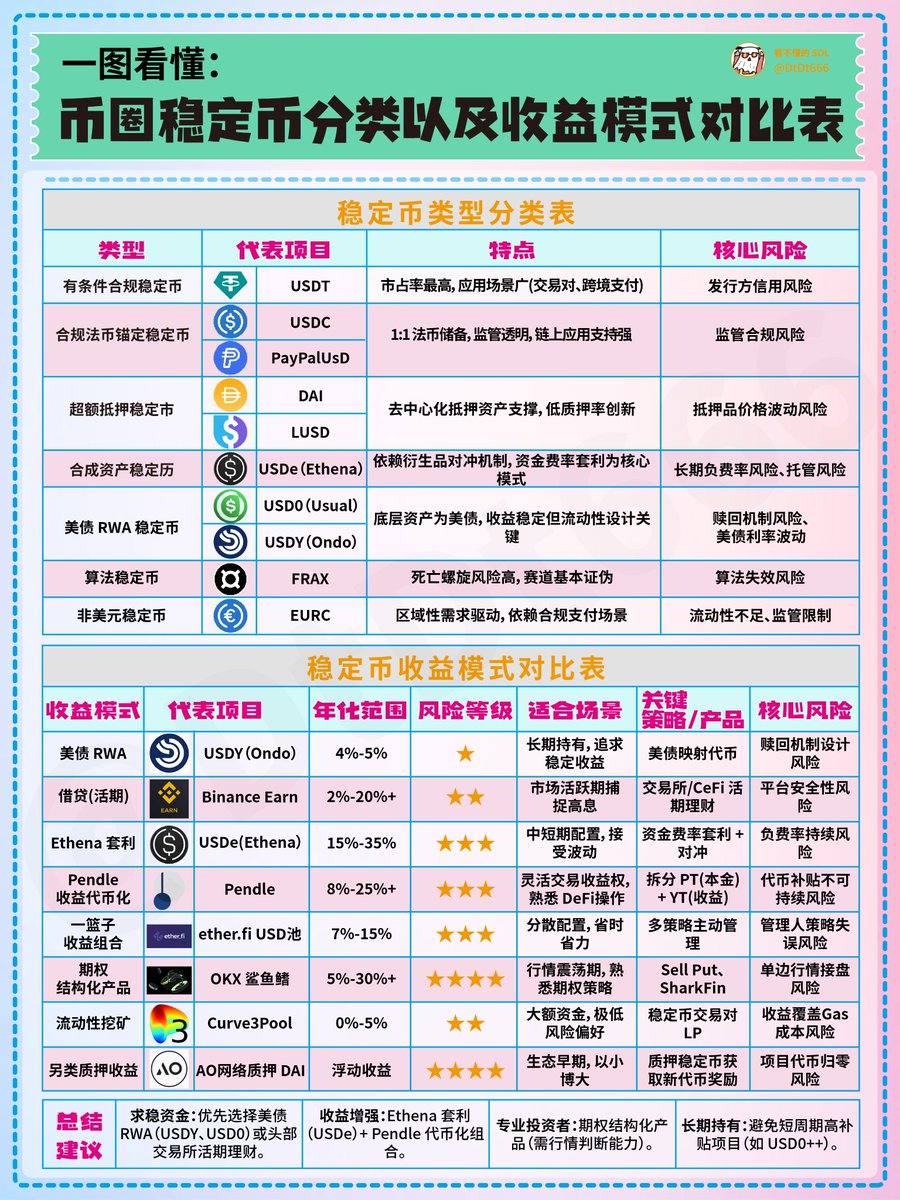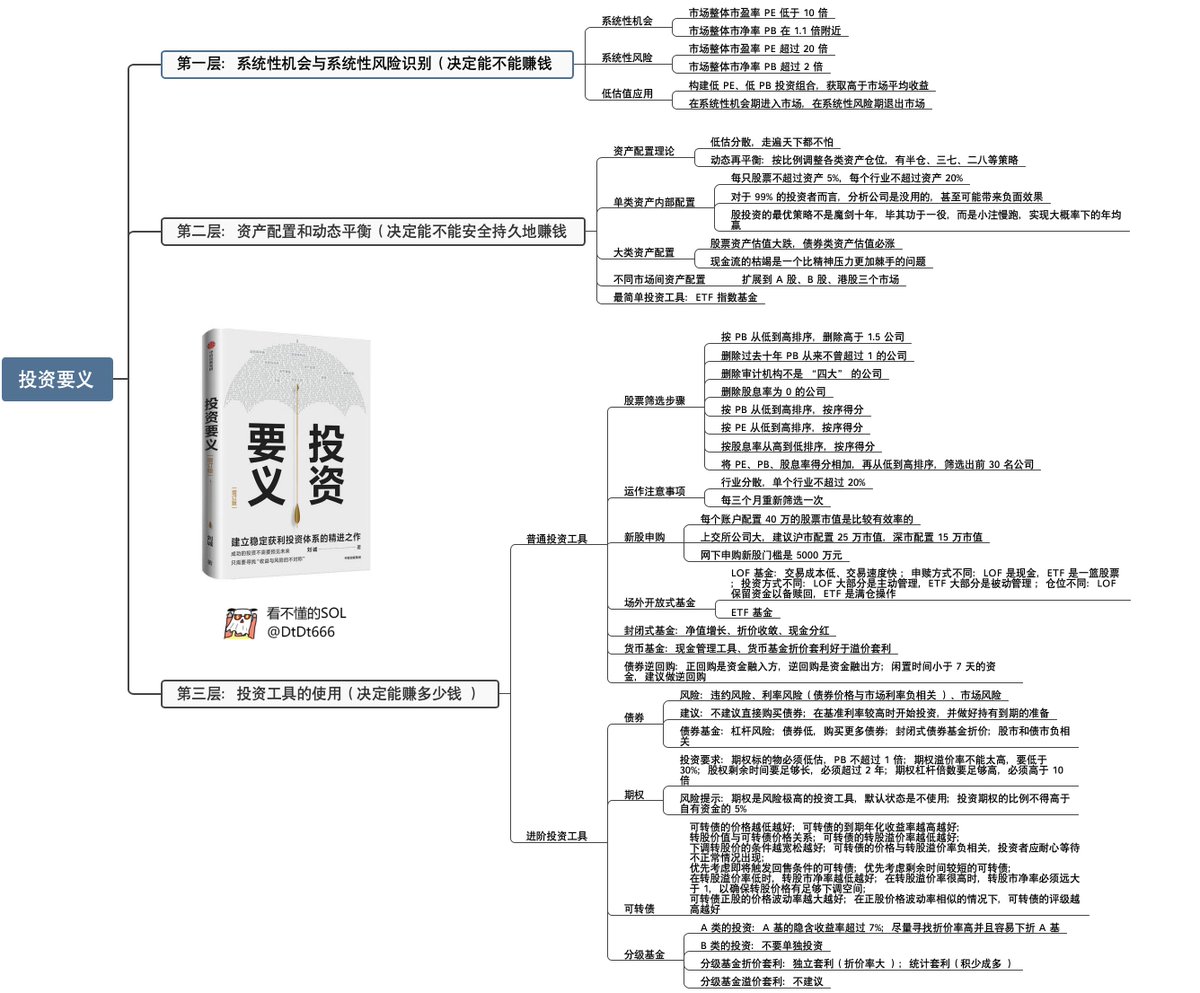After continuing yesterday's article, many brothers asked: Is there a stable financial management path with an annualized rate of 12-18% in the currency circle?
Today, I deliberately worked overtime to sort out an issue (rush work during the holidays, welcome to add!) )
1️⃣ Moderate (low risk):
U.S. bond RWA (such as USDY, USD0) has an annualized rate of 4%-5%, which is suitable for long-term holding.
Exchange current wealth management (such as Binance Earn) 2%-20%+, the head platform is safe.
2️⃣ Yield Enhancement (Medium and High Risk):
Ethena Arbitrage (USDe): 15%-35% annualized, relying on derivatives for hedging, but be wary of negative fee risk.
Pendle Yield Tokenization: 8%-25%+ annualized, flexible trading income rights, suitable for veterans familiar with DeFi.
3️⃣ High Play Option (High Risk):
Option structured products (such as shark fins, etc.) have an annualized rate of 5%-30%+, which requires a certain ability to judge the market.
Alternative staking (e.g., AO network staking DAI) has floating returns and high risk.
💡 Suggested combinations:
Seeking stability: U.S. bond RWA + current wealth management on head exchanges.
Bo income: Ethena arbitrage + Pendle tokenized decentralized allocation.

If you just want to earn 12%-18% annualized in the long term
One book is enough, "The Essentials of Investment".
I have read it a few times, there are principles and cases, concise and clear, simple and easy to understand.
You can read it for free on WeChat, and you can even save it for downloading.
It is no exaggeration to say that my daughter-in-law has made a cumulative profit of 100w so far, and half of the credit for this book. If there are no special circumstances, within three or five years, her cumulative profit will exceed 400w.
Not many people know about this book, but whenever someone asks, I recommend it, and everyone who has read it has come back to thank me without exception.
Let me share the key points for my brothers
The main theme of the book is sixteen words:
Undervaluation and diversification, balanced equity and debt;
The system is rigorous and the tools are abundant.
01. System
"The three tiers of the investment system are as follows.
Level 1: Identification of systemic opportunities and systemic risks.
Level 2: Asset allocation and dynamic rebalancing.
Level 3: Use of investment vehicles.
Among the three levels of the investment system, the more basic the level, the simpler and the more important it is.
The first level determines whether we can make money or not; The second level determines whether we can make money safely and durably; And the third level determines how much money we can make."
The first level identifies systemic opportunities and systemic risks, mainly based on the level of valuation, to determine whether the current investment returns more than the risks or the risks outweigh the rewards.
The second level of asset allocation and dynamic balance is to diversify risks and reduce the probability of clearing all at once.
The third level is to make money with the help of different investment vehicles, such as stocks, funds, bonds or convertible bonds.
02. Underestimated
Whether stocks are undervalued or not, the authors of this book mainly judge by the price-to-book ratio and price-to-earnings ratio.
"Valuation, you can refer to two very simple indicators – the price-to-earnings ratio and the price-to-book ratio.
1. Price Earnings Ratio (abbreviated as PE)
Calculation formula: stock price per share ÷ earnings per share, or total market capitalization ÷ company's annual net profit.
2. Price-to-book ratio (PB)
The formula is calculated as the share price per share ÷ net assets per share, or the total market capitalization ÷ the company's current net assets."
The author gives a simple indicator, with a P/E ratio of less than 10x being undervalued and more than 20x being overvalued; A price-to-book ratio of less than 1x is undervalued and more than 2x is overvalued.
I think there is no problem in judging the valuation based on the price-earnings ratio and price-to-book ratio, but the above indicators cannot be used generally, and the overvalued or undervalued values of the price-earnings ratio and price-to-book ratio applicable to different industries are also different.
However, the author's interpretation of the price-earnings ratio and price-to-book ratio is quite good:
"There are only two viable ways for shareholders of any company to get a return from the company: operating and liquidating. For investors, there are two perspectives on how to value the same company, namely "operating value" and "liquidation value".
Pay attention to how much money you can make each year by running this store, which is the thinking of the P/E ratio; Paying attention to how much money you can get back by selling your store is the price-to-book ratio thinking."
Before buying stocks, you can pay proper attention to the three indicators of price-earnings ratio, price-to-book ratio and even dividend yield.
If you want to win in investment, you must achieve "a little less fall in the bear market, and try to keep up with the rise in the bull market", and buying undervalued stocks can help to reduce the fall in the bear market.
03. Dispersion
"Stocks are risky, investment needs to be cautious", I believe everyone has heard this sentence, but where is the risk of stocks?
It is because a single stock is very volatile, and it may even be delisted if it is not well managed, or in a market like Big A, where the industry style rotation is very obvious, buying a single stock is often very risky.
How to deal with it. Asset allocation, diversification.
Stocks should not exceed 20% of the total assets invested in a single industry, and no more than 5% of the total assets invested in a single stock.
Asset allocation can reduce the risk of volatility and delisting of individual stocks.
Buying a broad-based index fund is also a type of diversification, as a broad-based index fund invests in different stocks.
04. Investment tools
The author introduces investment vehicles such as stocks, index funds, bond funds, and convertible bonds.
Whether the stock is invested in the company you are optimistic about, but it is still a single stock should not exceed 5% of the total investment capital, and a single industry should not exceed 20%.
Index funds are suitable for diversification, not only in A-shares, but also in overseas index funds through QDII to diversify the investment market.
Bond funds are relatively less volatile, and the appropriate allocation of bond funds can balance the volatility of the portfolio, and regular rebalancing to achieve buy low and sell high can even bring the same or higher returns while reducing volatility.
Because convertible bonds have the attributes of debt and equity, they are "guaranteed at the bottom, and there is no cap at the top", which is the biggest advantage of convertible bonds. However, because there are still situations where the company is unable to repay its debts, the advantage of having a minimum guarantee may not be able to be realized.
Overall, this book is still very good as an investment primer, "undervaluation" and "diversification" can ensure that a person's investment is invincible, and the other is to grasp the attributes of different investment tools and choose the right one for yourself.
Share!

243.78K
431
The content on this page is provided by third parties. Unless otherwise stated, OKX is not the author of the cited article(s) and does not claim any copyright in the materials. The content is provided for informational purposes only and does not represent the views of OKX. It is not intended to be an endorsement of any kind and should not be considered investment advice or a solicitation to buy or sell digital assets. To the extent generative AI is utilized to provide summaries or other information, such AI generated content may be inaccurate or inconsistent. Please read the linked article for more details and information. OKX is not responsible for content hosted on third party sites. Digital asset holdings, including stablecoins and NFTs, involve a high degree of risk and can fluctuate greatly. You should carefully consider whether trading or holding digital assets is suitable for you in light of your financial condition.

